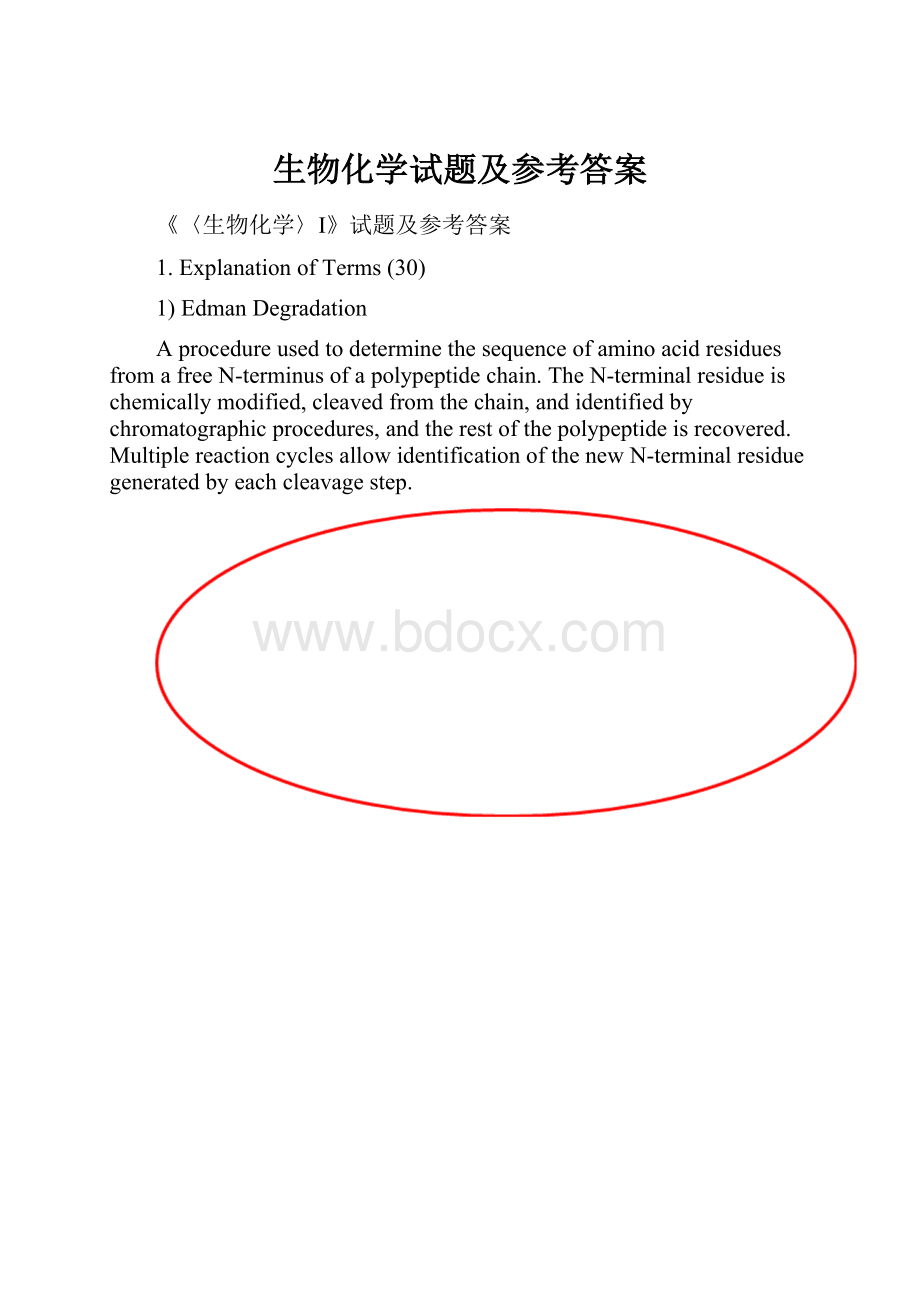生物化学试题及参考答案.docx
《生物化学试题及参考答案.docx》由会员分享,可在线阅读,更多相关《生物化学试题及参考答案.docx(20页珍藏版)》请在冰豆网上搜索。

生物化学试题及参考答案
《〈生物化学〉Ⅰ》试题及参考答案
1.ExplanationofTerms(30)
1)EdmanDegradation
AprocedureusedtodeterminethesequenceofaminoacidresiduesfromafreeN-terminusofapolypeptidechain.TheN-terminalresidueischemicallymodified,cleavedfromthechain,andidentifiedbychromatographicprocedures,andtherestofthepolypeptideisrecovered.MultiplereactioncyclesallowidentificationofthenewN-terminalresiduegeneratedbyeachcleavagestep.
2)ProteinKinase
Anyofanumberofenzymesthatphosphorylateoneormorehydroxylorphenolicgroupsinproteins,ATPbeingthephosphoryl-groupdonor.Theattachmentofphosphorylgroupstospecificaminoacidresiduesofaproteiniscatalyzedbyproteinkinases,andremovalofphosphorylgroupsiscatalyzedbyproteinphosphatase.
3)WesternBlotting
1.Separationofproteinsbygelelectrophoresis
2.Transfertheseparatedproteinstoamembrane
3.Membraneblockingwithnonspecificprotein
4.Incubatewithprimaryandsecondaryantibody(antibody-enzymecomplex)
5.Addsubstrate
6.Formationofcolored
4)ImmunoglobulinG(IgG)
ImmunoglobulinG(IgG)isthemajorclassofantibodymoleculeandoneofthemostabundantproteinsinthebloodserum.IgGhasfourpolypeptidechains:
twolargeones,calledheavychains,andtwolightchains,linkedbynoncovalentanddisulfidebondsintoacomplexofMr150,000.
5)GProtein
Guaninenucleotidebindingprotein;anyafamilyofheterotrimericGTP-bindingandhydrolysingproteins,theyareacomponentofreceptormediatedactivationorinhibitionofadenylatecyclaseandothersecondmessengersystemssuchasphosphatidylinositolcycle.Theymediatetheintracellularactionsofmanyhormones,growthfactorsandcytokines.Thesystemiswidelydistributedbutuniquetoeukaryotes.
6)DenaturationofProteinandDNA
Proteindenaturation:
Alossofthree-dimensionalstructuresufficienttocauselossoffunctioniscalledproteindenaturation(byheat,extremesofpH,organicsolvents,urea,guanidinehydrochloride,ordetergents).
DNAdenaturation:
ThecompleteunwindingandseparationofcomplementarystrandsofDNA.
7)GenomeandProteome
Genome:
Thewholeofthegeneticinformationofanorganism.ItiscontainedasDNAineukaryotiesandprokaryotes,andaseitherDNAorRNAinviruses.Agivenorganismhasonlyonegenomeregardlessofwhethertheorganismishaploid,diploid,orpolyploid.
Proteome:
Thecompleteexpressionprofileoftheproteinsofanorganism.
8)αHelixandβConformation
αHelix:
Conformationofapolypeptidechaininwhichsuccessiveturnsofthehelixareheldtogetherbyhydrogenbondsbetweentheamid(peptide)links.
βConformation:
Anextended,zigzagarrangementofapolypeptidechaininwhichthechainisalmostfullyextendedbutslightlypuckered.
ßsheet;Thezigzagpeptidechainscanbearrangedsidebysidetoformastructureresemblingaseriesofplates.
ßturns;Atypeofsecondarystructureinpolypeptidesconsistingoffouraminoacidresiduesarrangedinatightturn(180º)sothatthepolypeptideturnbackonitself.
9)TranscriptionandTranslation
Transcription:
ThesynthesisofeitherRNAonatemplateofDNAorDNAonatemplateofRNA.
Translation:
ThesynthesisofapolypeptidewhosesequencereflectsthenucleotidessequenceofanmRNAmolecule.
10)DNAPolymeraseandRNAPolymerase
DNAPolymerase:
TheenzymescatalysethesynthesisofDNAfromdeoxyribonucleosidetriphosphatesinthepresenceofanucleic-acidprimer.
RNAPolymerase:
Theenzymethatdirectstranscription,orsynthesisofRNA.
2.Description(30)
1)ThreemajorRNAprocessing.
Capping:
Thecapisastructuralfeaturepresentatthe5’endofmRNAmolecules.Itconsistsof7-methylguanosineandatriphasphatebridgelinkingit5’-5’totheendofpolynucleotidechain.CappingistheprocessofformingorplacingacaponanmRNAmolecule.Functions:
(a)ProtectmRNAsfromdegradation.(b)Enhancethetranslatability.(c)EnhancethetransportofmRNAsfromthenucleusintocytoplasm.(d)EnhancetheefficiencyofsplicingofmRNAs.
Polyadenylation:
Poly(A)isasequenceofadenylylresiduesatthe3’endofeukayoticmRNA.AlmostallmaturemRNAshave40-200nucleotidesofpoly(A)tail.Additionofpoly(A)tothe3’endofmRNAiscalledpolyadenylation.Functions:
(a)ProtectionofmRNA.(b)TranslatabilityofmRNA.
Splicing:
TheenzymicprocessineukaryoticcellsbywhichintronsareexcisedfromheterogeneousnuclearRNA(hnRNA)followingitstranscriptionfromDNA,andthecutendsarerejonedtoformmessengerRNA.
2)Threeclassesofgeneticrecombinationandtheirmajorfunctions.
HomologousrecombinationinvolvesgeneticexchangesbetweenanytwoDNAmoleculesthatshareanextendedregionofnearlyidenticalsequence.Functions:
(a)ContributestotherepairofseveraltypesofDNAdamage.(b)Ineukaryoticcells,itprovidesatransientphysicallinkbetweenchromatidesthatpromotestheorderlysegregationofchromosomesatthefirstmeioticcelldivision.(c)Itenhancesthegeneticdiversityinapopulation.
Site-specificrecombinationdiffersfromhomologousrecombinationinthattheexchangesoccuronlyataparticularDNAsequence.Functions:
(a)Regulatingtheexpressionofcertaingenes.(b)PromotingprogrammedDNArearrangementsduringembryonicdevelopment.(c)Completechromosomereplication
DNAtranspositionisdistinctfrombothotherclassesinthatitusuallyinvolvesashortsegmentofDNAwiththeremarkablecapacitytomovefromonelocationinachromosometoanother.Functions:
(a)Completechromosomereplication.(b)Moveonegeneticelementsfromonelocationtoanotherandmaintenanceofgeneticdiversity.
3)Fourtypesofweakinteractions(noncovalentbonds)withinandbetweenbiomolecules.
4)Eightmajorproteinfunctions.
1.Catalysis
2.Structure
3.Movement
4.Defense
5.Regulation
6.Transport
7.Storage
8.StressResponse
5)Thebiologicalfunctionsofthelipids.
1.Energystorage(fatsandoils).
2.Majorstructuralelementsofbiologicalmembrane(phospholipidsandsterols).
3.Others(enzymecofactors,light-absorbingpigments,hormone,electroncarrier).
6)DNArepairsystems.
Mismatchrepair:
AsystemforthecorrectionoferrorsintroducedduringDNAreplicationwhenanincorrectbase,whichcannotformhydrogenbondswiththecorrespondingbaseintheparentstrand,isincorporatedintothedaughterstrand.
Base-excisionrepair:
AdamagebaseisrecognizedbyanenzymecalledDNAglycosylase,whichbreakstheglycosidicbondbetweenthedamagedbaseanditssugar.Thisleavesanapurinicorapyrimidinicsite(APsite),whichisasugarwithoutitspurineorpyrimidinebase.OncetheAPsiteiscreated,itisrecognizedbyanAPendonucleasethatcutsornikestheDNAstrandonthe5’sideoftheAPsite.
Nucleotide-excisionrepair:
Bulkybasedamagecanberemoveddirectly,withouthelpfromaDNAglycosylase.Inthispathway,theincisingenzyme(excinuclease)systemrecognizesthestrandwiththebulkydamageandmakescutsoneithersideofthedamage,removinganoligonucleotidewiththedamage.
Directrepair:
OnetypeofDNAdamagerepairsystemwithoutremovingabaseornucleotide.
DNArecombination
3.Enzymesareextraordinarycatalysts.Therateenhancementsbroughtaboutbyenzymeareintherangeof5to17ordersofmagnitudeenzymesarealsoveryspecific,readilydiscriminatingbetweensubstrateswithquitesimilarstructures.Howcantheseenormousandhighlyselectiverateenhancementsbeexplained?
Wheredotheenergiescomefromforthedramaticlowingoftheactivationenergiesforspecificreactions?
Bindingenergyisamajorsourceoffreeenergyusedbyenzymestolowertheactivationenergiesofreactions.
1.Muchofthecatalyticpowerofenzymesisultimatelyderivedfromthefreeenergyreleasedinformingmultipleweakbondsandinteractionsbetweenanenzymeanditssubstrate.Thisbindingenergycontributestospecificityaswellascatalysis.
2.Weakinteractionsareoptimizedinthereactiontransitionstate;enzymeactivesitesarecomplementarynottothesubstratesperse,buttothetransitionstatesthroughwhichsubstratespassastheyareconvertedintoproductsduringthecourseofanenzymaticreaction.
4.DNAsequencingisreadilyautomatedusingavariationofSanger’ssequencingmethodinwhichthedideoxynucleotidesusedforeachreactionarelabeledwithadifferentlycoloredfluorescenttag.DescribethestrategyofautomatingDNAsequencingreactions.
5.Describetheseparationprinciplesofproteinsonthebasisofsize(size-exclusionchromatography),charge(ion-exchangechromatography),andbindingspecificity(affinitychromatography).
size-exclusionchromatography
ion-exchangechromatography
affinitychromatography
6.Writethree-letterandone-letterabbreviationsforthe20standardaminoacids.ThetopiccanbesimplifiedbygroupingtheaminoacidsintofivemainclassesbasedonthepropertiesoftheirRgroups.Describethefivegroupsandtheirproperties.
AminoacidscanbeclassifiedbyRgroup:
Nonpolar,aliphaticgroups:
Gly(G)Ala(A)Pro(P)Val(V)Leu(L)Ile(I)Met(M)
AromaticRgroups:
Phe(F)Tyr(Y)Trp(W)
Polar,unchargedRgroups:
Ser(S)Thr(T)Cys(C)Asp(D)Glu(E)
NegativelychargedRgroups:
Asn(N)Gln(Q)
PositivelychargedRgroups:
Lys(K)Arg(R)His(H)
《〈生物化学〉Ⅱ》试题及参考答案
1.ExplanationofTerms
(1)Apolipoproteins:
Apolipoproteinsarelipid-bindingproteinsintheblood,responsibleforthetransportoftriacylglycerols,phospholipids,cholesterol,andcholesterylestersbetweenorgans.
(2)Photorespiration:
Alight-dependentcatabolicprocessoccurringconcomitantlywithphotosynthesisinplants(especiallyC3plants)whereby